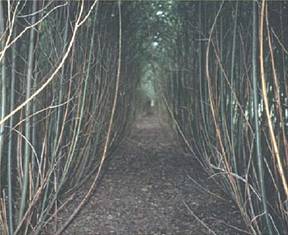The Greater Blue Earth River Watershed in south central Minnesota contains 2.2 million acres of highly productive farmland dominated by a corn/ soybean rotation and a strong, predominantly swine, livestock industry. Several aspects of the current corn/ soybean cropping system are not sustainable. Despite efforts to implement best management practices, soil and water quality continue to deteriorate and rural farming communities struggle to stay viable. Greater crop diversity is desperately needed, not only for the environment, but also to diversify farm economics and provide more value-added opportunities.
In 2003 the Blue Earth River Basin Initiative [BERBI] received funding to provide an incentive to agricultural producers to grow something other than corn or soybeans. Through implementation and demonstration, this project is designed to build toward a more sustainable system by providing transitional and risk incentives for establishing greater crop diversity which will increase land stewardship, reduce environmental impacts, and accelerate economic opportunity within rural Minnesota.
 |
Hybrid Willows are one alternative "third crop" promoted as an alternative to corm and soybeans. (Photo by T. Volk) |
The "Third Crop" program promotes the establishment and growing of crops other than corn and soybeans. We have a broad definition of 3rd Crop that not only includes traditional agricultural crops, agroforestry crops and natives, but would also promote the production of ecological and public goods through non-crop 3rd crops such as hunting leases, recreation, bird watching, eco-tourism, carbon sequestration, nitrogen farming and water storage. Third Crops are income generating on working lands. They could help maintain or establish new income opportunities to assist in maintaining rural Minnesota's economic vitality.
Examples of potential agroforestry 3rd Crops include hazelnuts, blueberries, high value hardwoods, nut species, grapes, decorative woody florals, biomass for energy and various fruit/ berry species. Agricultural crops include small grains such as oats, wheat, rye, buckwheat, flax, barley; various types of hay including alfalfa; and native plants for feed, energy or seed production. We are approaching these crops as options for "working lands," not land retirement. It is intended to create a working landscape that will build toward a more sustainable system - environmentally, economically and socially. Each 3rd Crop could have an economic benefit to the farm family. This will help support rural viability in the region.
Within the landscape, our efforts are targeted toward environmentally sensitive areas. These are areas that are susceptible to soil erosion, in close proximity to surface waters, floodplains, have steeper slopes or other environmental sensitivity such as sink holes. In our region these sites make up five to ten percent of the landscape. These are areas that traditionally may not have been the best for row crops. Agroforestry crops fit well into these locations within the landscape and provide opportunities for landowners as in many cases there are developed or emerging markets are already in place.
Identification, development and promotion of 3rd crop markets will be key for their adoption. Jeff Jensen is the Marketing Program Assistant for BERBI and is available to assist producers with general 3rd crop information, identifying existing markets, coordinating producers with those markets; and promoting the development of new market opportunities. Jeff can be reached at This email address is being protected from spambots. You need JavaScript enabled to view it.or 507-238-5449. Please visit our web site at www.berbi.org.
By Linda Meschke
Blue Earth River Basin Initiative, Fairmont, MN


